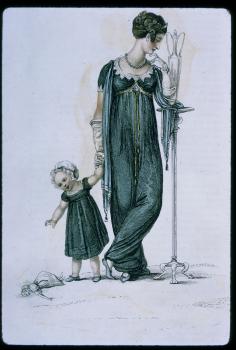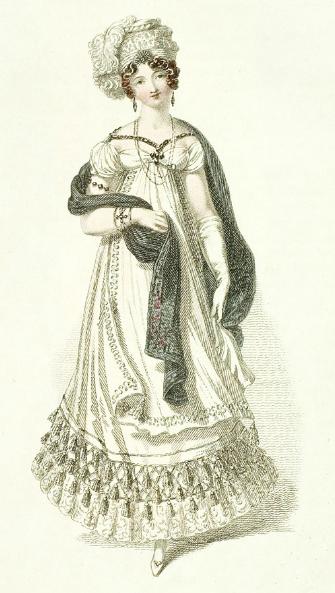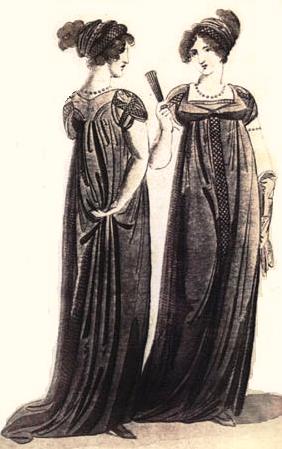
Belle Assemblee Morning Dress, 1818
Outward manifestations of grief have changed in mourning rituals over the centuries. These days when we think of 19th century mourning, we tend to confuse elaborate Victorian rules of the 1860’s with the less rigid mourning etiquette of the earlier 19th century. Mourning fashions during the Regency Period are fully described in Dressing for Mourning in the Regency on the Jane Austen Centre’s website. Only the wealthy could afford the specially made fashionable mourning outfits shown in the fashion plates featured in Ackermann’s Repository or La Belle Assemblee, but the rising popularity of fashion magazines meant that the details of dress quickly spread through the provinces. Most people remade mourning clothes from an existing wardrobe, adding new linings to cloaks and pelisses, covering existing bonnets with a new piece of crape, and dyeing old dresses. Jane Austen wrote about her mother in 1808: “My Mother is preparing mourning for Mrs E. K. – she has picked her old silk pelisse to peices, & means to have it dyed black for a gown – a very interesting scheme.”
One can imagine how an illustration like the one on the right would inspire women to add mourning details to their wardrobes, but such an expensive outfit would still be beyond most women’s means. The middle class was rising in numbers at a time when mourning clothes became more affordable through mass production of cloth. With these cheaper, more readily available clothes, the custom of wearing specially made mourning outfits (as opposed to remade) began to trickle down the social ladder. The very poor, who often did not own more than one outfit, could not afford to follow these wardrobe rules. They could not even afford the dark or black caps and bonnets that were worn with these ensembles. All they could manage at most was a touch of black, such as a ribbon or armband.

Ackermann, Mourning Dress,, 1819
One feature that characterized custom made or manufactured mourning clothes of the era were broad or deep hems of at least three inches. Women dressed in crêpe, the fabric of choice, or wore black bombazine silk, which had a matte finish as opposed to the sheen of regular silk, and converted their narrow hems into broad hems. Black was the only acceptable color in the first stage of mourning, which for widows and widowers lasted one year and one day. After the initial mourning period was over, the griever could choose wear subdued grays, purples, lilacs, and lavenders, as well as white, which had been the color of mourning during the medieval period. There were reports of widows choosing to wear heavy widow’s weeds for the rest of their lives, but in the early 19th century these decisions were made from choice and were not dictated by the inflexible example set by Queen Victoria.
Shiny material was unacceptable during heavy mourning, when only flat matte colors would do. Two stages of mourning – full mourning and half mourning – were already being followed, as evidenced in the fashion plates between 1800 and 1820. The subdued colors of half mourning were supposed to help a person transition to the brighter colors of regular wear, but for some, death was so common in an extended family that it might take some individuals years before they could safely abandon their mourning garb.
Women largely took on the burdens of official grieving. A man might be expected to wear a dark jacket black cravat, black or white shirt, black bordered handkerchief or armband, or a black ornament on his hat, but his life was not turned upside down like a woman’s, for he often wore black clothes as a matter of course.

Locket with Jane Austen's hair (?)
Early in the mourning process, only matte black jewelry made with jet or black amber could be worn. During the second phase of mourning, the wearer was given a wider choice of jewelry to wear. Jewelry made with the beloved’s hair, such as this brooch made (purportedly) with Jane Austen’s hair, was extremely popular and had a long tradition harking back to the 1600’s. In medieval times, giving a token of one’s hair was a gesture of love or courtship. (Willoughby took a lock of Marianne’s hair, which gave her family the impression that they were engaged.) Hair symbolized life, and was long-lasting. It is remarkable how “fresh” some of the hair samples in centuries old jewelry still seems today.

Evening Dress, Full Mourning, 1817
Widows and widowers followed stricter rules of mourning and for them the mourning period was the most intense and lasted the longest. Friends, acquaintances and employees mourned officially to a lesser degree, depending on their relationship to the dead person. ” The degree of the loss depends on the person, an infant had practically no value to society but adolescents were recognized more. Grandparents were not a marked loss as their usefulness had passed, the longest period is that of a spouse.” – Death.
Author Georgette Heyer, who knew the Regency Period backwards and forwards, included a passage in A Civil Contract in which the bride’s new family contemplated introducing her (Jenny) to Society after her husband’s father had recently died. It was obvious that her new mother-in-law could not introduce her, for she was still wearing the veil and observing the first stages of mourning:
[Lady Oversley] perceived the intricacies of the situation at once, and gave the matter her profound consideration. “She must be presented,” she decided. “It would have a very strange appearance if she weren’t, because one always is, you know, on the occasion of one’s marriage. And there is nothing improper in going to a Drawing-Room when in mourning, though not, I think, in colour—except lavender, perhaps. Only, who is to present her? In general, one’s mother does so, but poor Jenny has no mother, and even if she had—dear me, yes! this is a trifle awkward, because I don’t think you could ask it of your own mother. Not while she is in such deep mourning, I mean! Well, it will have to be me, though I am strongly of the opinion that if we could but hit on a member of your own family it would create a better impression.”
“My Aunt Nassington?” suggested Adam.
“Would she?”
“I think she might.”
It was traditional for the nation to mourn the death of a royal. Princess Charlotte’s death from childbirth in 1817 resulted in an elaborate funeral that rivaled the one held more recently for Princess Diana, and inspired the populace to wear black. This nation wide mourning was a precursor to the elaborate ceremonies that would be planned for Prince Albert’s funeral almost half a decade later in 1861.
More links on the topic:
*A special thank you to Laurel Ann of Austenprose and my blog partner at Jane Austen Today for sending me most of the images for this post.

Half mourning evening dress, 1819
Read Full Post »













